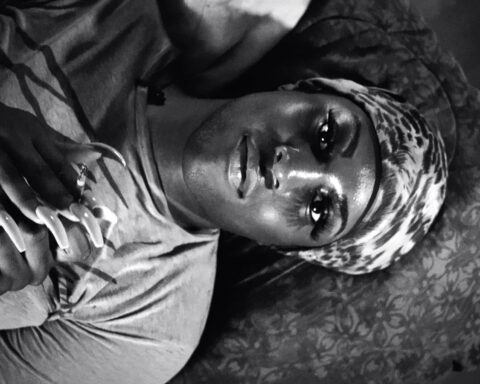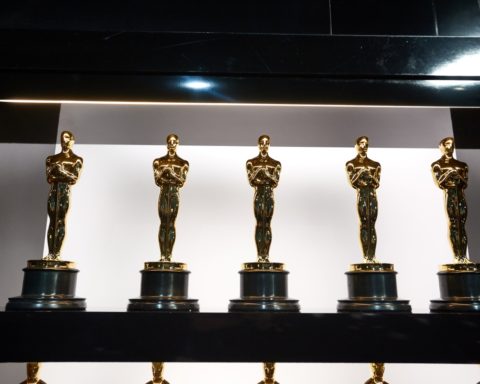A strange rush of emotions is guaranteed to run through you as you watch Inside Lara Roxx, the documentary feature by Montreal filmmaker Mia Donovan that is equal parts revealing, sad, confounding, hopeful, infuriating and sensational. Roxx made headlines in 2004 when the then-22-year-old was trying to make it big in the Los Angeles porn milieu, only to contract a virulent form of HIV.
As one of only a small number of porn actors to suffer such an outcome, Roxx soon became tabloid and mainstream media fodder, igniting international headlines. In the realm of contemporary journalism, Roxx’s story was a perfect storm, involving pornography, betrayal and what some clearly saw as a moral (if you play with fire, don’t be surprised if you get burned). Roxx’s tale drew so much attention that she ended up being interviewed by the likes of Diane Sawyer and Maury Povich.
Roxx’s revelations drew solid ratings, as she recounted having gone to Los Angeles with high hopes and getting swept up in the idea of making a quick fortune by having sex in front of a camera. She also believed industry types when they said all the performers involved had been tested repeatedly and that her chance of contracting HIV was virtually nil.
Donovan carefully places this media phenomenon into context, showing us how Roxx did her best to weather it, and how she attempted to confront her past through trips to L.A. and Las Vegas, and how addiction would ultimately land her in rehab. It’s a harrowing journey, but it’s also one of those powerful docs that manage to forge beyond the valley of the tabloids. Yes, Roxx’s story is innately sensational—how can it not be?—but Donovan treats Roxx with a respect that gives the film and its subject depth and humanity.
It was during the initial media firestorm that Roxx caught the interest of Donovan. “I saw Lara on [the French network] TVA where she was being interviewed in studio,” recalls Donovan. “I remember immediately feeling badly for her. She looked like someone who could easily be manipulated. I worried that someone would take advantage of her.”
But Donovan had other reasons for a certain connection to Roxx: her own work experiences. “I used to strip when I was in school,” she recalls, of her time doing a BFA at Concordia University. “I had a bit of insight into the types of people, the girls and guys, who are in that industry. I met so many girls who were exactly like her. I felt badly for her right away. I felt kind of angry too—I could tell immediately that someone had taken
advantage of her.”
At that time, Donovan was working as a photographer, and was capturing a series of sex workers and strippers for an exhibit she was planning. “Her [Roxx’s] lawyer was working as her agent at the time, so I wrote to her through him, requesting a meeting and hoping she would model for me.”
But Donovan heard nothing. And after months passed, she assumed Roxx was not interested and would never be in touch. Donovan proceeded with her photo series of strippers and sex workers, which would open in Montreal to critical accolades.
Then, a year later, a call came out of the blue. “She phoned me and wanted to talk. We started to have some conversations. She was a bit erratic, but I could tell she was sane. I think she was just going through a confused time. Then about a month later, she checked into hospital. When she called me from hospital, she said she wanted me to come and film her, to show what the world had done to her. She was a bit delusional at the time—she spoke of having her own reality-TV show—but I could tell it was just a phase. She was having a breakdown.”
Donovan immediately sensed that this was not the time to start gathering footage of Roxx, who was in the throes of a crisis. “I wanted to give her some time to get herself back together.” A year later, she met up with Roxx, this time with a camera. The irony is that Donovan had written to Roxx asking if she could take her photograph; Roxx had mistakenly assumed that Donovan was a documentary filmmaker, and thus suggested the idea for a film or TV series.
“She actually got the idea for a documentary film in my head,” says Donovan. “When I would photograph people, I would often hear their stories and think they were fascinating. It struck me that I should really be making documentary films about them instead of just capturing them in still photos. I always wanted to do something with that world, because I had worked with so many women who were misrepresented or didn’t have much of a voice. She brought it up, and the idea stuck.”
From the moment she knew she wanted to make a film about Roxx, Donovan also knew she did not want to rush the project—this story had already been told at the breakneck pace many journalists operate at, and had suffered as a result. “That’s why it took so long for me to shoot the film. I could have done something quickly quite easily, especially during that first year when she was in hospital. She needed attention and would have done pretty much anything. I didn’t want to take advantage of her like that.
“I kept reminding myself that I had to be patient and that it might take a long time. I remember even her dad saying, ‘Shouldn’t you finish this fast so that people remember her name, and then the film will be more successful?’ To me, it really wasn’t about that—it was about getting to know her as she became more grounded, rather than in her more erratic, drug-induced state.”
When asked about her main cinema influences, Donovan responds that “I love a lot of the observational documentary filmmaking.” Which surprises me, given the deeply personal nature of her storytelling style in Inside Lara Roxx (not to mention the film’s quasi-cheeky, porn-sounding title).
And then, a not-so-surprising response: the first documentary she mentions by name is none other than Grey Gardens. The landmark 1975 Maysles Brothers documentary is cited as a major influence by numerous filmmakers—everyone from Todd Solondz to Patricia Rozema—but it’s particularly intriguing here, given that it has become the textbook case of the paramount ethical dilemma facing non-fiction filmmakers: am I exploiting my subject? What some saw as a fascinating glimpse into the lives of a mother and daughter who went from being aristocrats to living in squalor in their dilapidated mansion, others regarded as a leering, cruel, voyeuristic portrait of two people who were clearly mentally ill or demented (or both). Albert Maysles continues to defend the film, dismissing its detractors’ arguments: “Little Edie was not schizophrenic,” he wrote to me in an email in 2008, correcting me after I’d described her that way in an article. “Eccentric, nonconformist, but definitely not schizophrenic.”
Donovan felt able to handle this dilemma because of her own connections to strippers and porn actors, but also because she was witnessing some of the over-the-top excesses of the most brazenly tabloid TV shows and their treatment of Roxx. Her appearance on the Maury Povich show was, perhaps not shockingly, like hitting rock bottom. Roxx was offered a mere $100 to appear on the show, and when she negotiated to get $500, the woman working on the show’s behalf claimed she almost lost her job due to paying Roxx such an exorbitant sum. The actual programme wrapped itself up as a cheap morality tale, with Roxx pushed to warn young people about the horrors of what could happen to them if they followed her sordid path. She was handed scripts and repeatedly coached to say the things she did. As Roxx recalls it, there was nothing spontaneous or real about it.
“She knew the entire thing was ridiculous,” says Donovan. “But she thought someone might see the show and listen to her. I felt like she was grounded enough to make the decision to go on.”
The clips from Povich’s show add another dimension to the film, as does the Diane Sawyer interview, indicating how many different ways Roxx has been represented, and how intoxicating all of that attention clearly proved. But even more amazing—and more disturbing—are the outtakes from porn movies in which Roxx appeared. Scenes from two different videos show Roxx with various men, ready to engage in what was clearly unprotected sex.
Scenes from one of her first appearances, titled Bi Boys and never actually released, shows Roxx embracing two men. The shoot actually took place in Montreal and was produced by local porn creator Vid Vicious. “He didn’t want anything to do with my film, but when I offered him money, he saw it as a business deal and then gave me the footage,” Donovan remembers. (Donovan suspects Bi Boys was never released because the two men actually engage in sex after having sex with Roxx, and sex between men in hetero porn remains taboo.)
Montreal’s EyeSteelFilm, a team Donovan describes as “amazing,” has produced Inside Lara Roxx. But she also recalls that when she first approached EyeSteelFilm co-founders Daniel Cross and Mila Aung-Thwin about the idea, they were cool to it. “The first thing they saw was the hospital scene,” she says. “I don’t think they wanted anything to do with it.” But this only cemented Donovan’s resolve. “I went back to shoot more footage.”
She returned to EyeSteelFilm after two years, this time loaded up with tens of hours of footage. Cross went to her home and they spent the day watching approximately seven hours of Roxx’s complicated, messy life. “When I saw these rushes, I could see Mia had a grass-roots connection to what she was filming,” says Cross. After his groundbreaking documentary work on the homeless — The Street and S.P.I.T. in particular—Cross says it was very important for him to see this connection. “I could clearly see why it was so important for Mia to make this film. Her own past indicated a depth of involvement in the story.”
Donovan says there was a hidden bonus in not having a production house backing her when she was gathering her footage. “If I’d had a real budget and a crew, the film would have been much different. If I’d had a sound guy with me the whole time, I think it would have been harder to get some of those interviews.”
One especially memorable interview has Donovan talking to one of Roxx’s boyfriends, known only as “Wolf.” Clearly high on something, Wolf recounts having just stabbed someone in the hallway of Roxx’s apartment. “I wasn’t sure what he was saying, as my French isn’t that good,” Donovan says. “Then Lara held up a bloodied shirt and I realized what he was saying. He never would have told me all that if I’d had a cameraman or sound guy with me. Having no crew is part of why the film is so intimate.”
Intimate it is. I ask Donovan about the issue of the filmmaker/subject relationship, and the fact that some directors advocate a certain distance between the two. In particular, I cite this statement, which documentary filmmaking icon Frederick Wiseman made when I interviewed him in 2000: “When I’m filming, I try not to give the impression that enduring friendships are being formed, because I think that’s basically false. I don’t like to trade on the instant-intimacy thing.”
Donovan concedes that she and Roxx have become “very close friends” but offers no apologies for it. “I really can’t imagine not allowing myself to develop a friendship with any of my subjects; I’ve always been that way, even with photography. Especially dealing with complex characters like Lara, or as Maysles did with Little Edie and Big Edie in Grey Gardens — they never would have gained access to their lives had they not developed a friendship. For me, I could not have made this film the way I did had I not developed a caring friendship for Lara. I have a lot of respect for her and care for her well-being, and that was part of the inspiration I needed to keep shooting for over five years.”
Getting to know Roxx so well meant that Donovan could go beyond the headlines and see a real and whole person. “My editor Omar Majeed was extremely good at helping me with this. I think he really saw her as a person, rather than just as a porn star or addict. He had compassion for her and gave people something they could relate to. That was the biggest challenge. When you know somebody, it’s different. Even friends I’ve had who are open-minded have tended to say things like, ‘Well, she was working in porn, what did she expect?’ We had 120 hours of footage to cut down to feature length, to tell her story and explain who and what she was about.”
After several conversations with Donovan, I requested an interview with Roxx herself. Now in a rehab institution just outside of Montreal, Roxx has limited phone access, but Donovan said she’d do her best. Just hours before my (extended) deadline, Roxx called me.
“Yes, I had second thoughts about doing this,” a soft voice tells me. “But I trust Mia. We have become very good friends.” Roxx also notes that she was always promised the chance to see a rough cut and the final cut, and give notes. “Mia never gave me a script, unlike the Maury Povich show, where they make you say stuff.”
Roxx adds that she had high hopes when she agreed to make the film. “I thought maybe I could help a few girls. But I think that was probably an illusion. Most young girls, the age I’m thinking of, are not drawn to this kind of film. Girls who are 18 are going to bars or horror or romance movies. They’re not going to see it. The people who are most likely to see a documentary like this are already open-minded about the issues it deals with.”
And before Roxx has to go, she has one final, more practical concern. “I know my boyfriend’s friends may see this and find out about me. They might recognize me and that might be a problem for them.
“For some people, this is still a problem.”











